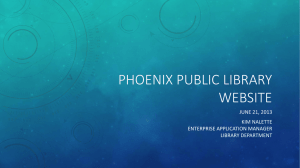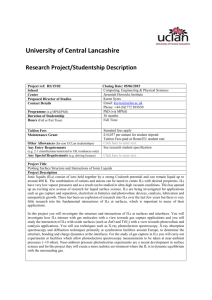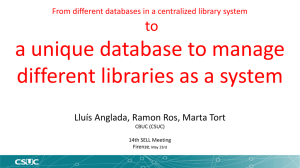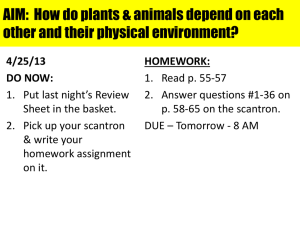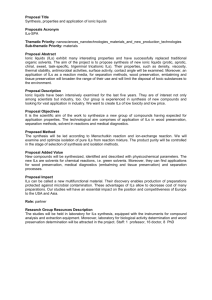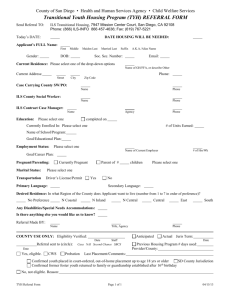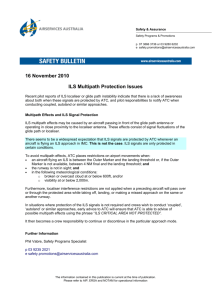L545 Systems Analysis & Design
advertisement
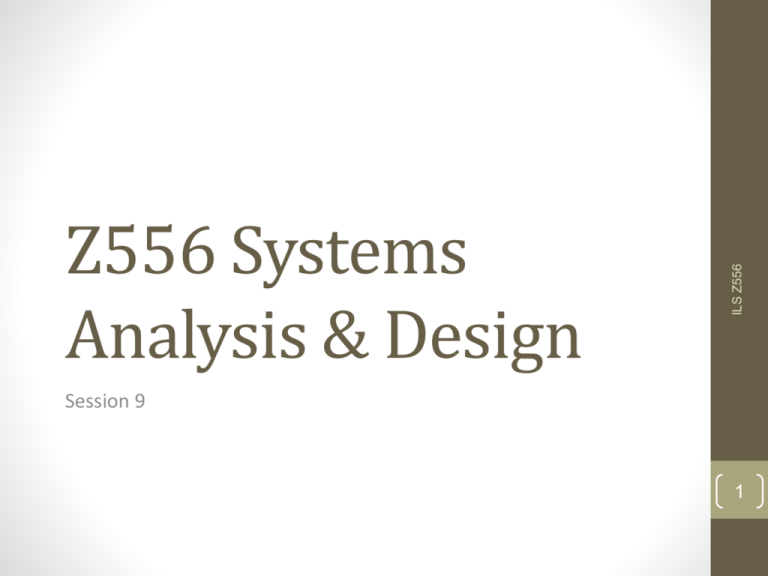
ILS Z556 Z556 Systems Analysis & Design Session 9 1 • 15 minutes • Present your teamwork process, not the findings about the project • Use artifacts • Everyone should be involved in the presentation ILS Z556 Team Process Presentation on November 20 2 ILS Z556 Feedback Meeting (Block, 2011) Be honest & authentic 3 • Show where the breakdowns and bottlenecks are • Elevate what would otherwise be a bunch of anecdotes to reveal systemic problems • Give the IT dept. a way to talk back to the business about prioritization decisions ILS Z556 Consolidated Models 4 • Show the common structure of a task across a customer population • Use the flow model to identify the important tasks • Only consolidate tasks that the system will support, that you will redesign, or that you need to understand in detail ILS Z556 Consolidating Sequence Models 5 Example of Consolidated Sequence Model • Prepare study guide for class/make lecture notes available to students Activity Intent Abstracted Steps Create study guide Create additional materials based on course lecture to help students prepare for assignments Finding Share lecture/ study guide Share Upload Share lecture study guide with students Breakdowns lecture to Oncourse Schedule office hours to review lecture Upload study guide to Oncourse ILS Z556 digital versions of images that match the text book images List image #s (DIDO #s or textbook #s) to be reviewed List terms necessary 20 MB per PPT lecture requirement in Oncourse which either suggest faculty to break up lectures or to meet size requirements 6 • Step 1: generate complete list of responsibilities for each individual • Step 2: examine each responsibility • Step 3: recognize when different people play the same roles • Step 4: how roles map to individuals • Step 5: consolidate the artifacts and communications between people ILS Z556 Consolidating Flow Models 7 Consolidated Flow Model: Consider Roles First - Keep track of what’s in the kitchen - Provide oversight & instruct other cooks as necessary - Make sure cooks are working together - Communicate exact needs to shopper - Decide on desired meals for special event with event planner - Find out what’s needed to restock inventory Cook - Negotiate meals and who will make them with other cooks - Coordinate with head chef on use of kitchen - Make sure ingredients for planned meal are available - Coordinate with head chef on how to make meal ILS Z556 Head chef Shopper -Find out from head chef what to buy and when to go - Make on-the-spot decisions about substitutions -Bring accounting of expense to fund manager 8 Event planner Funds manager Consolidated Flow Model: Add Artifacts & Interactions - Keep track of what’s in the kitchen - Provide oversight & instruct other cooks as necessary - Make sure cooks are working together - Communicate exact needs to shopper - Decide on desired meals for special event with event planner - Find out what’s needed to restock inventory list of ingredients Manage cooks Cook - Negotiate meals and who will make them with other cooks - Coordinate with head chef on use of kitchen - Make sure ingredients for planned meal are available - Coordinate with head chef on how to make meal ILS Z556 Head chef Shopper -Find out from head chef what to buy and when to go - Make on-the-spot decisions about substitutions -Bring accounting of expense to fund manager 9 Event planner Funds manager 10 ILS Z556 • Individual models show the structure and usage of the things people create and use • Consolidated artifact models shows common organizing themes and concepts that people use to pattern their work ILS Z556 Consolidating Artifact Models 11 • How it chunks • Use the structure of the artifact to guide the structure of the system • Maintain the distinctions that matter to users • What it looks like • Determine the intent of the presentation details • Mimic the intent of presentation details, not the details themselves ILS Z556 Consolidated Artifact Model 12 Consolidated Physical Model • Don’t depend on what’s not there • Account for movement and multiple locations • Take advantage of what is there ILS Z556 • The reality check 13 Consolidated Physical Model • Pitfalls • E.g., if people don’t have printers by their desks, don’t build a system that requires frequent trips to the printer • E.g., If your users walk around all the time, don’t try to tie them to a desk by giving them a product that only runs on a desktop ILS Z556 • Not taking the physical environment seriously 14 15 ILS Z556 • Indicates a direction for the design • Shows within that direction what constraints have to be accounted for • Managers need to monitor and manage the values of an organization • Make sure the changes you introduce will cause someone in the customer population to take notice (get buy-in) ILS Z556 Consolidated Cultural Model 16 Consolidation • The affinity diagram: • Consolidation helps us understand intent, strategy, structure, concepts, and mind-sets to support customers ILS Z556 • Data from individual users to groups 17 • Product consulting • Prescription consulting • Collaborative (Process) consulting • ~= Block’s Flawless consulting ILS Z556 Comparing Various Consulting Models (Schwen, 1995) 18 Dealing with Resistance (Block, Chapter 9) ILS Z556 • Step 1: Pick up the cues • Step 2: Name the resistance • Step 3: Be quiet, let the client respond • Consulting with a stone (p. 157) • Don’t take it personally 19 User Language That Is Avoid Language That Is Descriptive Judgmental Focused Global Specific Stereotyped Brief Lengthy Simple Complicated ILS Z556 Feedback Session (Block Ch 14, p. 223) 20 • Consultant as witness • Consultant as judge • Consultant as jury • Consultant as prosecutor • Consultant as defendant ILS Z556 Feedback Session (Block Ch 14) 21 • Problem statement • Why the problem exists • What happens if the problem is not fixed • In the short term • In the long term ILS Z556 A Structure of a Feedback Meeting (Block, p. 229, 2nd ed.) • Recommended solutions • Expected benefits 22 ILS Z556 Affinity Diagram 23 ILS Z556 The Affinity Diagram (see Chapter 8 in HWW) 24 The Affinity Diagram data data Sub-problem ILS Z556 Problem Label data Labels Sub-problem Sub-problem 25 • Get diverse perspectives • Inquiry into the consolidated work models • Brainstorms new work practice • Develop multiple solutions ILS Z556 Contextual Design for Invention 26 • Synthesize across the models • Discuss the models and possible metaphors in the team, which leads to shared understanding and perspectives • Data consolidated models design ILS Z556 Using Models for Design 27 • To look across the different models and see a unified picture of work practice • To use multiple perspectives to reveal the issues • To use multiple possibilities to drive the invention of a creative design solution ILS Z556 Goals of Work Redesign 28 ILS Z556 Goals of Work Redesign 29 Affinity Model Exercise • Each team will fill out 20 index cards (interpretation notes) + 5 color index cards (category notes) • Write down “data (e.g., The principle includes a personal note on each printed e-mail that he sends to the teacher)” related to issues from either interviews or observations on the 20 index cards • Chunk these 20 cards into some categories • Use the color index cards to label these categories ILS Z556 • Goal: Build affinity model based on these cards 30 ILS Z556 Affinity Notes 31 ILS Z556 Affinity Diagram 32

